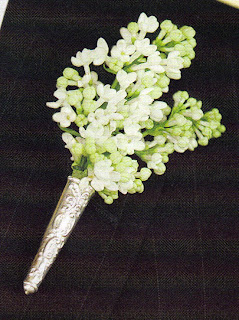
SOMETHING OLD, SOMETHING NEW, SOMETHING BORROWED, SOMETHING BLUE
Grandma's pearl necklace, a new shade of lipstick, Mom's hairpin and a garter laced with blue satin. Each token represents an element of married life to look forward to. Something old symbolizes continuity. Something new offers optimism for the future. Something borrowed represents good fortune and serves as a reminder that the bride can depend on her friends and family. And something blue stands for purity, love and fidelity. Now, isn't that something?
THROWING RICE Nothing says "I do" like the celebratory tossing of rice. Symbolic of fertility and prosperity, rice is thrown by guests as an offering of these good tidings. In some cultures, rice was once thought to ward off evil spirits because, clearly, well-nourished evil spirits pose no harm.
THE BRIDE'S ATTIRE No part of a wedding is steeped in as much lore as the bride's attire.
The veil - The veil's purpose has evolved over eras and across cultures. In the case of arranged marriages, the veil was worn to hid the bride's face so that the groom could not change his mind about the marriage. In other instances, the veil served as a barrier to the bride's face so that her husband would not be killed for her beauty. In arid regions, the veil served both to protect the bride from the wind and sun and as a way to preserve her modesty. Later as a symbol of virginity, only first-time brides traditionally wore the veil.
Wedding Attire - Anne of Brittany became the first officially documented bride to wear white during her 1499 marriage to Louis XII of France. Because of its impracticality, white was generally reserved for nobility. In other parts of the world, white was worn among all social classes. In ancient Egypt, brides were draped in white linen. Roman brides were wrapped in pleated white robes in tribute to Hymen, the god of fertility and marriage, who was purportedly taken with the color.
The Garter—As with most traditions, the origin of the garter varies depending on who is asked and in what part of the world they live. The most prominent tales insist that newlyweds were once expected to consummate their marriage immediately following their ceremony. Family and friends commonly entered the room to watch, taking the garter as proof. Another version states that, in 14th-century Europe, guests tore pieces of the bride’s dress for good luck until, quite often, she was sans clothing. Modesty aside, the act was downright barbaric, and savvy brides soon threw items at the guests—often drunk men—to stave them off. Thus, the throwing of the garter.
SHARING THE FIRST PIECE OF CAKE There’s nothing better than watching a newly united couple, clad in the finest garments they’ll likely ever wear, shove sloppy pieces of cake into each other’s faces, right? Not if you wish for health and prosperity, says Sharon Cole, co-director of the Association of Bridal Consultants, San Diego Region and owner of A Dream Wedding by Sharon. “The tradition of feeding the wedding cake symbolizes a new family unit, although it also shows that the bride and groom will care for each other and nourish each other during the good times and hardships of their marriage,” she says. “Smashing the cake into your spouse’s face would mean that you do not care for their health or prosperity and that outside influences—the guests screaming for the pleasure of watching this display—will influence your marriage.”
CARRYING FLOWERS Darn those evil spirits, floating about so menacingly. The herbs and flowers in a wedding bouquet were said to ward them off if, by chance, the rice or veil didn’t do the trick. During plague-infested periods, garlic was used as an aromatic deterrent from England to Rome to China. Flowers commonly found in bouquets symbolize purity, joy and an array of other emotions, according to Cole. The rose, for example, symbolizes pure love. The red tulip represents powerful love, while yellow indicates hopeless love. Baby’s breath represents hope of procreation and new life and the tuberose indicates dangerous pleasures. The lily of the valley signifies the return of happiness.











































 The warm colors in the bouquets were set off perfectly by the bridesmaids' espresso dresses and was a perfect color scheme for a summer wedding in the vineyard.
The warm colors in the bouquets were set off perfectly by the bridesmaids' espresso dresses and was a perfect color scheme for a summer wedding in the vineyard. 






 A very sophisticated cake by Cakes to Celebrate.
A very sophisticated cake by Cakes to Celebrate.